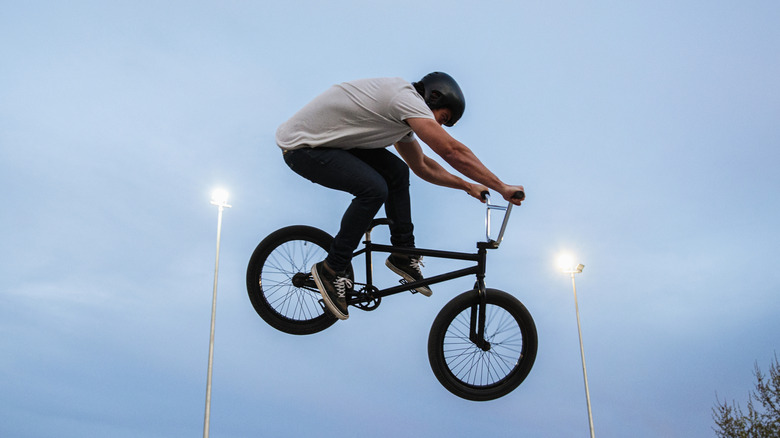What Does BMX Stand For & When Did The Sport Begin?
Even if you're not knee-deep in the extreme sports world, odds are you've heard of BMX at some point. Perhaps you've even seen BMX events on television or depicted in movies, with skilled bike riders putting their lives on the line to perform incredible feats and win tense competitions against the best of the best. You may even own a BMX-capable bike, with some of the best and worst mountain bike brands out there leaving their mark on the sport. Despite all of this, though, the meaning of BMX can be far from common knowledge, even for those a bit more in-tune with the sport.
Fortunately, it's no big secret what BMX actually means. The three-letter acronym technically only stands for two words: bicycle motocross. As mentioned, BMX is all about pulling off awe-inspiring tricks, safely and quickly navigating obstacle courses, and, to a much lesser extent, competing in races. This isn't unlike motocross, which differs most notably in the sense that its riders take on challenges riding dirt bikes — once upon a time, doing so on the classic dirt bikes that paved the way for modern off-road motorcycles. Swap out the motorcycle for a bicycle, and you have BMX.
While many don't refer to it by its extended name or even know what it means, BMX has a rich history behind it. Let's go back to how it all began.
BMX events have their roots in the 1970s
To chart the history of BMX, one has to look back to the start of the 20th century. Motocross was born in the United Kingdom at the start of the 1900s before making its way over to the United States. It became quite popular over time, with the youth finding it especially endearing. Fast forward to Southern California in the 1970s: While kids didn't have motorcycles of their own to do dangerous stunts and tricks with — and certainly not any of the rarest dirt bikes ever built — they did have their regular, non-motorized bicycles. Thus, they started to tweak them for speed and handling, taking the first steps into what became known as BMX.
In short order, the sport-in-the-making took off. Egged on by director Bruce Brown's 1971 film "On Any Sunday," which opened with a makeshift BMX race, kids everywhere took it upon themselves to modify their bikes and set out for adventure. While it's unknown who exactly came up with the BMX label, it caught fire all the same, revolutionizing the way kids looked at and interacted with their bikes. With the 1980s on the horizon, the enthusiasm and culture surrounding BMX continued to grow, leading to the creation of the American Bicycle Association (ABA). The ABA helped organize the sport, giving meaning to the races and setting up rules and rankings to abide by.
All these years later, BMX endures as a staple of popular culture. In fact, it's showcased routinely on the biggest stages possible, making it far more than a neighborhood pastime.
BMX has gone far beyond neighborhood fun
BMX began as a fun emulation of motocross, but it has ultimately become a beloved sport in its own right. It has even made its way to the Olympic Games. BMX racing was added to the docket in 2008, when the games took place in Beijing, China. Meanwhile, its other form, BMX freestyle, joined the fray for the 2020 games, hosted by Tokyo, Japan. Racing is pretty straightforward, while freestyle is more imaginative. These events involve specific time limits, typically around two minutes, where riders have to chain tricks throughout a designated area. At the end, they receive scores for their efforts based on criteria like style and difficulty.
Of course, one would be remiss not to talk about one of the most famous BMX — and extreme sports in general — showcases around. For three decades, the X Games have served as one of the premier platforms to witness those in BMX, motocross, skateboarding, and other extreme sports do what they do best. In the modern era, the X Games features several BMX-centric events, including BMX dirt, park, and street competitions. These all take place in different environments and call for different skillsets for those involved. Throughout all of these events, riders from around the world take part in hopes of taking home the top spot.
What started out as something done by kids for fun has grown to become a real-deal sport. Being born of innovation, it'll be interesting to see where BMX goes in the coming decades.


